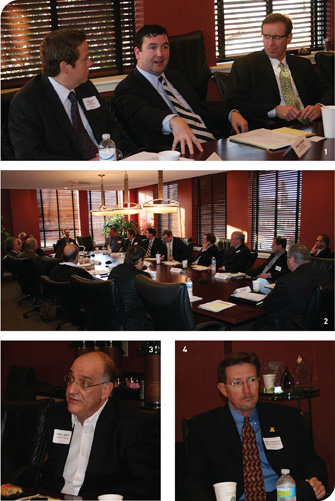
1. The Internet, said Chase Simmons, may change retailing, but its reach wouldn't make coffee shops, restaurants or bars obsolete. | 2. The conference room at RED Development was full-up for a candid discussion of commercial realty and retail operations. | 3. Even the Plaza, said Jerry White, had seen some non-traditional uses for retail space. | 4. Mike Downing pointed out that the state's programs for developmental incentives were under an intensive review.
Retail Fundamentals
“I’m sure you focus on fundamentals even more so today than before,” Dan Lowe said to the retailers in the room, and he asked them what they looked for when considering a new location.
“Obviously, we’re trying to shrink our box a little bit,” said Ed Brownell of Spin!. He noted too that with banks looking harder at finances, the retailers must weigh the impact of tax incentives, taxes, and CAM charges [common area maintenance]. “The states are still getting big tax money,” he added. “It would be nice to be able to put some pressure back on them to get some relief on the tax side.”
Chase Simmons asked the retailers how they felt about a shopping area whose other properties were shifting to non-retail uses like churches or tennis facilities.
“It’s important for us to maintain a certain image,” said Brownell. “So I don’t know how I’d feel about a church going in a center that was a premium grocery store site. Co-tenancy is important for a brand.”
Jeff Berg wondered whether other uses—medical or dental, for instance—were detrimental in that they, too, draw regular traffic.
“I think it’s all on an individual basis,” said Gail Lozoff. She did not have a problem with most other types of tenants as long as the fundamentals were in place, such as easy access and good parking.
“Our preference would be to have retail,” said Mitch Truster of Beauty Brands, especially if those retailers are advertising and bringing customers to the center. “The non-retail uses don’t excite us.” David Block noted that in some of the lesser centers, “GSA-types of uses,” like a driver’s license center, produce useful traffic even if they do increase CAM.
Home-Grown Business
The question was raised as to how friendly the Kansas City area and the current environment were to the creation of new business, especially new retail business.
Jerry White observed that one need not go far to find the answer. Downstairs from RED Development on the Country Club Plaza is a seasonal outlet for DERMAdoctor, a growing Kansas City-based company headed by physician Audrey Kunin. The company manufactures a line of skin-care products and is moving into retail as well.
“It seems like you’re seeing a lot of new restaurants,” added Owen Buckley. “A lot of people are tired of the chains, the big national chains. They want to go to something that’s authentic and real.”
One obstacle for small start-up retailers, said Gail Lozoff, is the difficulty of finding an appropriate location. She noted a relative lack of shopping areas like Brookside and Prairie Village, main streets with both traffic and quaintness. “I feel like there’s kind of a dearth of that kind of development in Kansas City,” said Lozoff, “maybe that’s the infill thing.” These kinds of start-ups, Lozoff believes, would feel lost at a Town Centre or Country Club Plaza.